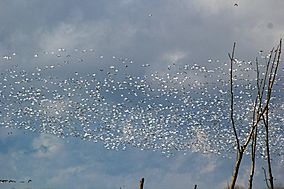Chautauqua National Wildlife Refuge facts for kids
Quick facts for kids Chautauqua National Wildlife Refuge |
|
|---|---|
|
IUCN Category IV (Habitat/Species Management Area)
|
|

Snow geese in winter
|
|
| Location | Mason County, Illinois, United States |
| Nearest city | Havana, Illinois |
| Area | 4,388 acres (17.76 km2) |
| Established | 1936 |
| Governing body | U.S. Fish and Wildlife Service |
| Website | Chautauqua National Wildlife Refuge |
The Chautauqua National Wildlife Refuge is a special place for wildlife. It is located in Mason County, Illinois, right along the Illinois River. The U.S. Fish and Wildlife Service takes care of it. This refuge is one of four important wildlife areas along the Illinois River.
Contents
How the Refuge Was Formed
The refuge covers about 4,388 acres (17.8 square kilometers). Most of this land is a wetland, which means it's a watery area like a swamp or marsh. This land is also called "bottomland" because it's low-lying land next to a river.
From Farmland Attempt to Wildlife Haven
Long ago, this area was known as the Chautauqua Drainage and Levee District. In the 1920s, people tried to turn this wetland into farmland. They built large walls of earth, called dikes, around the area. This was an attempt to create a "polder," which is land reclaimed from water.
However, the people in charge couldn't afford to keep the dikes strong. The Illinois River eventually broke through and reclaimed the land. This created a wide, shallow lake called Chautauqua Lake.
Becoming a Protected Area
In 1936, the United States government bought this land. They decided to manage it for wildlife and to help control floods. Over the years, managing floods has become harder. This is because water flowing from farms carries dirt and other materials into the river. This process, called siltation, makes Chautauqua Lake shallower.
In some parts of the lake, the silt has built up so much that new land is slowly forming. This new land might become a mix of small waterways (called sloughs) and forests that grow in floodplains.
Wildlife and Challenges
The Chautauqua National Wildlife Refuge is home to many animals and plants. However, some of the species here are not native to the area. These are called nonnative or invasive species. A well-known example is the Asian carp, which can harm the local ecosystem.
What Animals Live Here?
As of 2005, a large part of the refuge, about 3,200 acres (12.9 square kilometers), was open water. Another 800 acres (3.2 square kilometers) had water and trees. The remaining 388 acres (1.6 square kilometers) were upland forest, which is higher ground with trees.
In the winter of 2005-2006, a pair of bald eagles was seen nesting in the refuge. This was an exciting sight, as bald eagles are a symbol of wildlife conservation.
Other Parts of the Refuge
The Chautauqua National Wildlife Refuge also has another section. It is called the Cameron/Billsbach Unit. This part is located further north in Marshall County, near Henry, Illinois. It adds another 1,079 acres (4.37 square kilometers) to the refuge.


